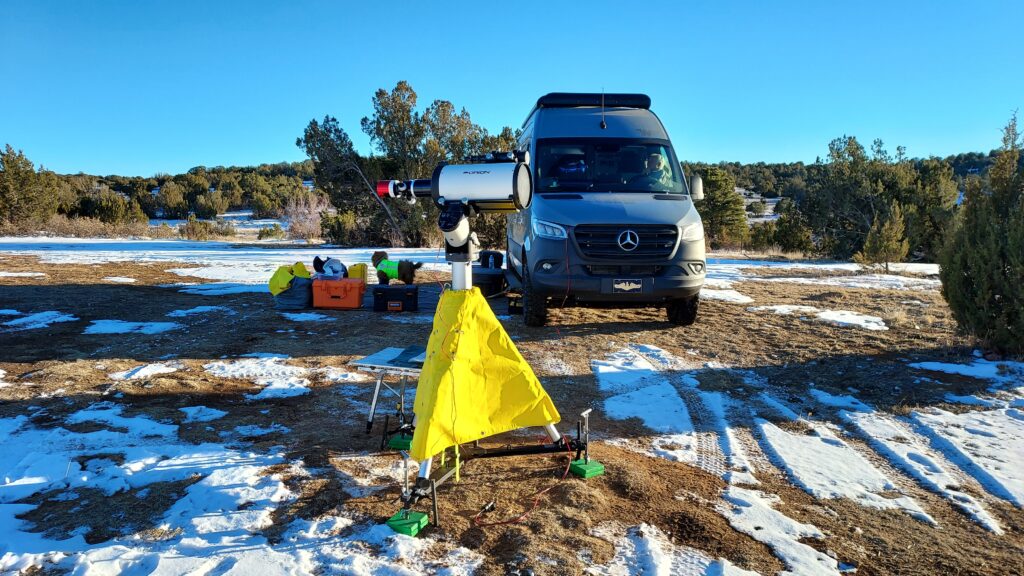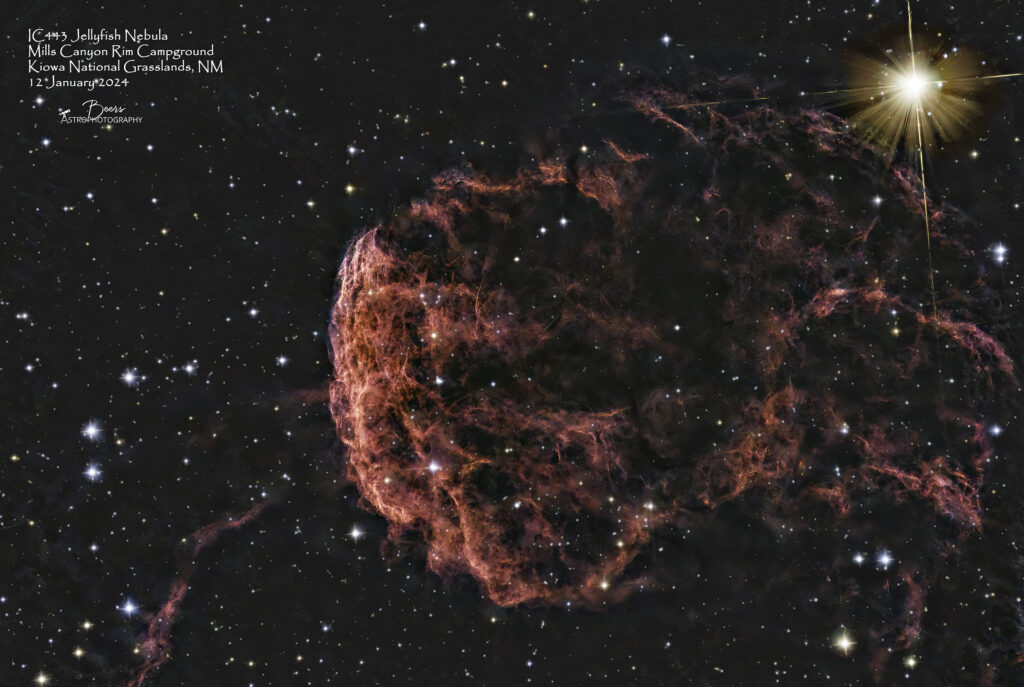Mother Nature was doing her best at detering us from a January 2024 dark skies trip. BUT, when she opened a one night window assuming, like we have in the past, we wouldn’t take advantage of it, she didn’t understand just how desperate I’d become…

A Night in the Beast in Kiowa National Grasslands
Mother Nature was doing her best to cancel our 10-13 January 2024 dark skies trip. But, we (okay, I) saw a ray of hope! About a week out, it began to look as if we’d have one night at Kiowa National Grasslands. In the past, we’ve never made a trip if the window was only allowing for a single night of imaging…to far to drive, too much set-up and tear-down for a single night of data collection. But…I’m getting desperate! 2023 only gave me five nights in dark skies and only two of those were in the Beast. So, not only was I desperate for dark skies, but the Beast needed to get out and “have his pipes blown out.” So, we did it. At first it seemed like it was going to be Wednesday night (10 Jan 2024), but then that window closed and a few days later Friday night’s window opened. Paul wasn’t crazy about the idea, between the cold and the wind – but I persisted and we packed up on Friday morning for an overnight “cold camp” (just bringing the microwave and some heat-and-eat food).
We departed HCH at 0915 and were in place at a spot on the edge of the Kiowa National Grassland’s Mills Canyon Rim Campgrounds by 1400. At Paul’s urging due to the impending wind forecast (and only one secure base), although I’d brought both Big Bertha and the Southern Cross with intentions of imaging with both, I just set up Big Bertha. As I was setting up, I decided to forego the EAF, because of the cold and wind I was struggling with the small screws and lock washers connecting it to the bracket. In the constant cold, I decided it wasn’t as important and just another factor that could mess up the collect (as I still haven’t gotten the autofocus in the middle of the collect (currently set to run autofocus every 60 minutes) to work correctly.
I’d originally planned to image the Garlic Nebula until about midnight and then switch to the Jellyfish Nebula. I started out having issues plate solving on the Garlic, which turned out likely to be due to the power issue and lack of fully tightening the autoguide scope that I experienced with the collect throughout the night, but at the time I thought it was because of the wind and didn’t want to risk the 10 minute exposures in those conditions. So, I made the decision to collect on IC443 Jellyfish Nebula all night long.
All night, turned out to end at 2300MST when I went out to do the meridian flip to find that the mount was locked up in RA. Lesson (re-)learned (or should I say learned after the situation was presented a second time?). You cannot power all the equipment (laptop, mount, and camera) from a single DC feed. I need to have a dedicated DC feed for the mount and use the second one for the laptop and camera. I first experienced this in January 2022 when the EQ-6R kept “freezing” in RA on the night’s second target when I had both BB on the EQ-6R and the Southern Cross running. At that point, I attributed it to temperature and the equipment really “freezing up” only to find – wasn’t the equipment freezing but the lack of sufficient power.
To park the mount (which was frozen its pre-flip position – and the laptop was locked up), I had to connect the handset – that’s when I began to get the clue. The hand-set was beeping and displaying a flashing “Error in RA.” It took a few minutes for me to notice, it also said (in the flashing error message) “Voltage = 11.1V” At that point, I turned off the power to the laptop and camera – which raised the voltage error message to say 12.0V. That was still not enough to move the mount in RA more than a small fraction of the way it had to move before it would stop in error. So, I went into the Beast and turned on the motor – which charges the battery. That did the trick to allow me to get the mount parked!
That also gave me the confidence that perhaps I could continue the sequence. Wrong! On the first plate solve attempt, the mount didn’t move anywhere near the target and gave me an error that even the blind solving had failed because “it appears that the target is not in the frame.” At that point I decided a few more hours of data were not worth the price of ruining my new $9K mount…so I packed up the cabling (leaving the rest of the disassembly for the morning light) and went to bed.
We packed up and returned home on Saturday morning, departing Kiowa National Grasslands at approximately 0830. It was an interesting drive home. Very windy between Kiowa and Raton Pass. At the top of Raton, it was 36°F. A few minutes later, near the bottom of the pass, the temperature had dropped to 7°F! There was a huge cold air mass trapped under blue skies, then fully engulfing us, then out of it into the bitter cold that had settled into Colorado. We got home at about 1200 to a windy, blustery 17°F and the temperature continued to drop throughout the afternoon and night. Good that we went (and came home) when we did!
This is the image captured during one night (okay, half a night) on 12Jan2024 from the gloriously dark and clear skies of the Kiowa National Grasslands. The “rest of the story” is in the IC443 Jellyfish Nebula gallery page, here: https://beersastrophotography.com/gallery/ic443-jellyfish-nebula/

Stand-by for more updates to the IC443 Jellyfish Nebula gallery page coming soon… I just finished stacking (by two different methods – one using a simple APP 5-session stack and the other using the APP RGB Combine tool.
